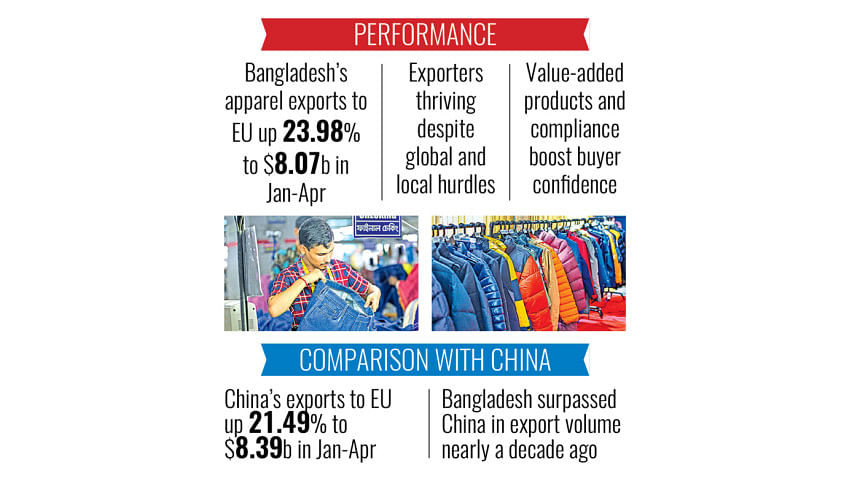Bangladesh closing in on China in RMG export to EU

Even amidst the tough times at present, garment shipments to the European Union (EU) showcased resilience as Bangladesh fared well in the January-April period, showing signs of an opportunity to overtake China, the largest apparel supplier worldwide, in the EU markets.
In the January-April of this year, apparel shipments to the EU, the largest export bloc for the country, surged by 23.98 percent to $8.07 billion from $6.51 billion in the same period of the last year, according to Eurostat data.
The data showed that China's apparel exports to the EU reached $8.39 billion, up from $6.90 billion in the same period in 2024, with a growth rate of 21.49 percent in value and a remarkable 7.37 percent increase in unit price.
Bangladesh is very close to overtaking China on garment exports to the EU in terms of value while surpassing China, the largest apparel supplier worldwide nearly one decade ago, in terms of volume in the same markets.
The local apparel suppliers have been enjoying a very favourable duty on shipment of their products at zero percent under the EU's generous Generalised Scheme of Preferences (GSP), named Everything But Arms (EBA), under least developed country (LDC) category.
Also, in some product categories, such as trousers and denim, Bangladesh has overtaken China both in the EU and the US in recent years.
Following the announcement of Trump's higher reciprocal tariff rate at 37 percent, the local garment exporters have been focusing more on the EU markets rather than the US market, which also helped increase the export of garments to the EU.
During this period, garment shipments to the EU increased not only in terms of value, but also in terms of volume and unit price by 19.71 percent and 3.57 percent respectively, the data also said.
Bangladesh remained indomitable in garment export to the EU, despite the current trade tension.
The worries were for geopolitical issues, heavy exchange rate fluctuations for US dollar shortages, higher inflation in the West, severe gas crisis in the industrial units, high bank interest rate, severe fallouts from the Covid-19 and Russia-Ukraine war.
Also, the overall import of garments by the EU in the January-April period increased by 14.21 percent to $32.49 billion.
During this period, the growth was accompanied by a notable 15.84 percent spike in volume and a 1.41 percent decrease in average unit prices in the EU as the demand for the locally made garments increased to this trade bloc.
India, Pakistan, and Cambodia also experienced substantial growth rates during this period.
However, Turkey faced a 5.41 percent decrease in apparel exports to the EU, amounting to $3.10 billion in the January-April period.
Meanwhile, Vietnam recorded a 15.62 percent growth, reaching $1.48 billion in exports with a 5.68 percent increase in unit price, the Eurostat data also said.
India, Pakistan, and Cambodia secured $2.01 billion, $1.42 billion, and $1.56 billion in exports to the EU, respectively, with growth rates of 20.58 percent, 23.42 percent, and 31.78 percent, respectively.
Bangladesh has performed well in the EU markets because of an increase in the unit price, restoration of buyer confidence for standard and compliance improvements, export of high value-added garment items and product diversification, said Faruque Hassan, managing director of garment exporter Giant Group.
If adequate energy is supplied and political stability is ensued, garment exports to the EU will continue to grow in the near future, he said.
Vidiya Amrit Khan, vice-president of the Bangladesh Garment Manufacturers and Exporters Association (BGMEA), said Bangladesh exported more value-added garment items, which contributed to an increase in value.
However, China's capacity in garment export is much higher than that of Bangladesh, she added.

 For all latest news, follow The Daily Star's Google News channel.
For all latest news, follow The Daily Star's Google News channel. 



Comments